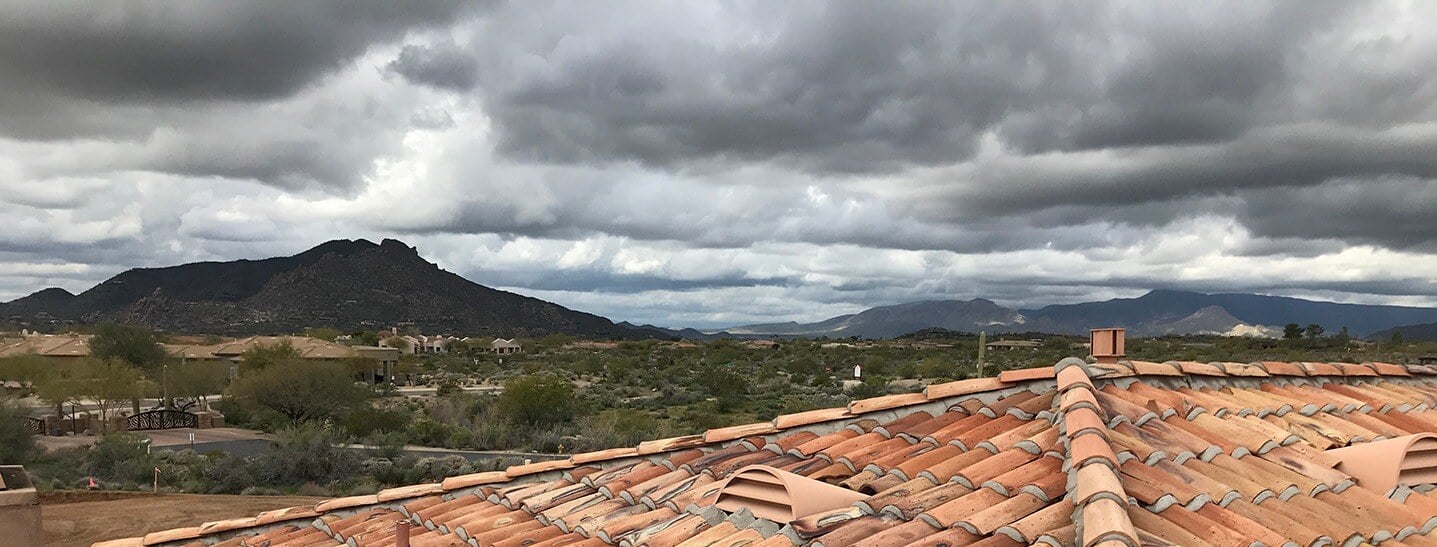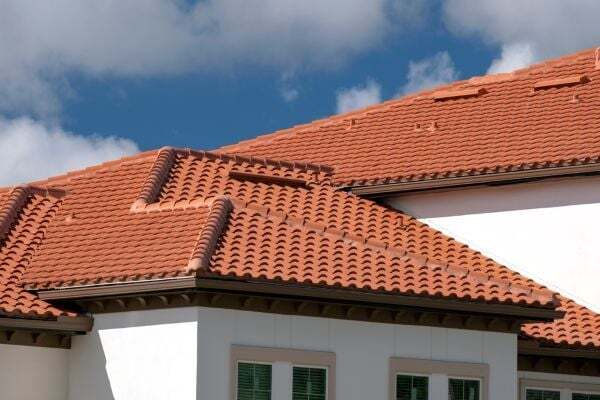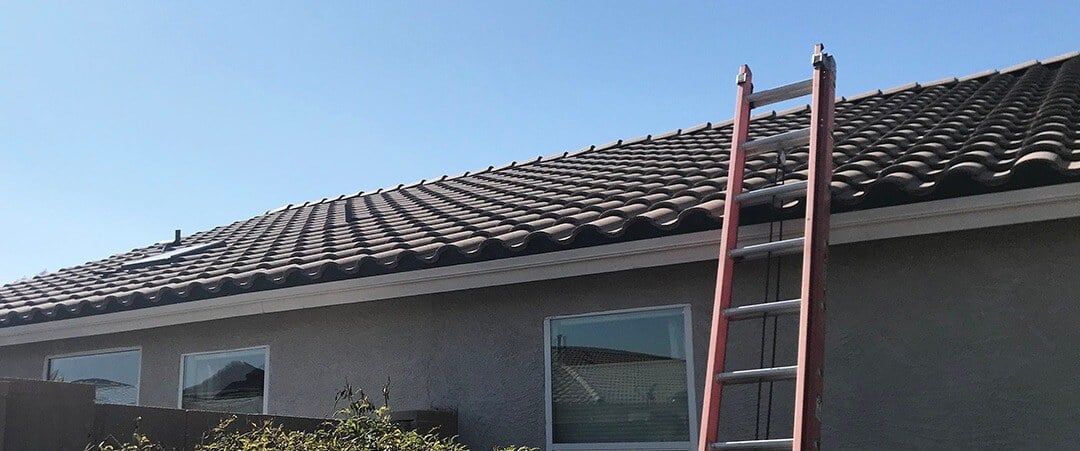7 min read
Emergency Roof Repairs in Arizona: What to Do After a Storm
Timber Luketich, Project Manager : July 04, 2025

We’re just about entering Arizona’s monsoon season, and its high winds and heavy rain can wreak havoc on your roof. Before we get hit with the storms, it helps to know what to do in case your roof experiences damage.
In this article, we’ll share what roof damage to look for after a storm, what to do if your roof has been damaged, and preventative measures you can take to protect your roof before monsoon season.
Signs of roof damage after a storm
Even if there are no signs of immediate damage, it’s important to inspect your roof after a storm to spot potential issues before they get worse. Here are some things to look for:
Visible roof damage
Start by inspecting your roof from the ground. Look for missing or broken shingles or tiles, torn flashing, or areas that appear dented or lifted. Monsoon winds can exceed 70 mph, so even heavy shingles can be torn off or loosened. Debris like tree branches can also leave impact damage behind.
Look over everything with a critical eye, because even minor damage can lead to serious water intrusion if it’s not addressed quickly.
Damage to gutters, vents, or roof fixtures
Next, you can check your gutters to make sure they haven’t bent, come loose, or filled with debris. Damaged gutters can prevent proper drainage and lead to water pooling on your roof.
You can also inspect vents, flashing, skylights, and other roof features. Look for cracks, exposed fasteners, or signs that flashing has pulled away. These are all common places for water leaks to begin.
Attic or ceiling leaks
Now head inside and inspect your attic or upper-level ceilings. Water stains, discoloration, mold, mildew, or sagging drywall are all red flags. If you notice any of these signs, it’s likely that water is already getting into your home and in need of immediate repair.
Don’t put yourself at risk
Tempted as you may be to assess the full extent of the damage, avoid climbing onto your roof yourself. It’s not only dangerous, but walking on storm-damaged roofing can cause even more harm to your roof. Instead, contact a licensed Arizona roofing contractor like Azul Roofing Solutions, who can perform a thorough inspection safely and recommend any necessary emergency repairs.
See: Replace vs Repair a Roof: Factors to Consider Before You Decide
What to do if your roof is damaged after a storm
If you think your roof has taken damage after a storm, it’s important to act quickly to avoid further damage and the need for more permanent repairs. Here’s what to do, step-by-step:
1. Assess the extent of damage
The first thing to do is assess the extent of the damage with your safety in mind. If your home appears to have any structural damage, exposed wiring, or feels unsafe in any way, evacuate and call emergency services.
If it looks and feels safe, inspect your roof from the ground. Generally, inspecting your roof in the early morning or late afternoon light can make it easier to see uneven or damaged areas from a distance. If that’s not possible, you can use a flashlight, binoculars, or a zoom lens on your phone to look for:
- Missing, lifted, or curled shingles
- Fallen tree limbs or debris on the roof
- Damaged gutters, vents, or flashing
- Dents in metal window frames or siding.
If your gutters or siding have visible damage, it’s likely your shingles will also be damaged.
Inside your home, check the ceilings and attic for:
- Water stains or dripping
- Mold or mildew
- Sagging drywall or peeling paint.
2. Make temporary fixes if needed
If your roof is leaking, you need to take immediate steps to prevent damage to the inside of your house. Here are some things you can do:
- Place buckets or containers under leaks to catch water
- Move any valuables and electronics away from the affected area
- Use a tarp to cover any exposed sections of the roof, and secure it tightly with nails or weights.
If you’re dealing with smaller holes or cracks, you can apply roofing cement or a similar sealant as a temporary measure. These quick fixes won’t solve the problem permanently, but they can buy you a bit of time until professional help arrives.
Don't underestimate the risk that water leaks can pose to your home. Firstly, they can cause rotting spots and a sagging roof. If you don't resolve these issues by the time summer's heat hits, what could have been a minor repair is likely to turn into a complete new roof installation.
3. Document the damage
Before you clean up or make any repairs, make sure to thoroughly document the damage. Take photos from multiple angles, both inside and outside the home. Be sure to include:
- Wide shots of the affected area
- Close-ups of specific damage
- Photos of any displaced shingles, broken tiles, or debris in the yard.
This documentation will be important when it comes to the next step: filing a claim with your insurance company.
4. Contact your insurance company
Once you’ve assessed and documented the damage, notify your homeowner’s insurance provider right away. They’ll guide you through the insurance claim process, which usually involves:
- Submitting photos and a description of the damage
- Schedule an adjuster visit to assess the damage in person
- Providing estimates from licensed roofing contractors.
Make sure to keep records of all your communication and receipts. If possible, you might want to have a trusted roofing contractor present during the insurance inspection to make sure that nothing has been overlooked.
See: Is Your Roof Covered Under Homeowner's Insurance?
5. Call a professional roofing contractor
Temporary fixes can help prevent additional damage in the short-term, but only a licensed roofing professional can accurately assess and repair your roof. Contact a qualified roofing contractor in your local area and let them know that your roof has been damaged in the recent storm.
They’ll be able to:
- Perform a detailed inspection, including hard-to-spot issues like hidden leaks or structural weakening
- Provide a clear, written estimate for repairs
- Work with your insurance company to streamline the claims process
- Make sure all work is completed to code and backed by a warranty.
At Azul Roofing Solutions, our emergency roof repair team is trained to respond quickly and thoroughly after storm damage. We’ll conduct a thorough inspection, give you a detailed estimate, and work quickly to repair or replace your roof.
6. Follow your insurance company’s instructions
Finally, make sure you follow all instructions given by your insurance provider. They might require additional documentation, repair quotes, or an inspection before authorizing roof repair work.
To streamline the claims process, make sure to stay in touch with your insurance representative, meet any deadlines or requirements for paperwork, and confirm approval before you start major repairs.
Once the claim has been approved, your roofing contractor can move forward with the necessary roof repairs or replacement.
How to prepare your roof for storm season
Now you know what steps to take if your roof has been damaged after a major storm. But what are some preventative measures you can take beforehand? Below are some ways you can prepare your roof for Arizona’s monsoon season.
1. Inspect your roof for damage and wear
Before we get hit with the monsoon rains, it helps to thoroughly inspect your roof for any wear and tear. Even minor issues can turn into major leaks under monsoon conditions. Look for early signs of deterioration like:
- Cracked, curled, or missing shingles or tile roof materials
- Sagging rooflines or soft spots (especially on flat roofs)
- Rusted or exposed nails
- Stains, mold, or water damage in the attic or on interior ceilings.
If you’re not sure what to look for, schedule a free roof inspection with Azul Roofing. Our licensed Arizona roofers will assess your roof and recommend any necessary repairs before the rains hit.
2. Clean out gutters and downspouts
Gutters are your roof’s drainage system. If they’re clogged, rainwater backs up, pools on your roof, and finds its way inside. For that reason, it’s essential to keep them clear before storm season.
Here are simple steps to clean out your gutters:
- Remove leaves, twigs, and debris by hand or with a gutter scoop or trowel
- Flush out any remaining dirt with a hose
- Run water down the downspouts to make sure they’re draining away from your foundation
- Check for any signs of rust, sagging, or separations in the gutter joints.
You can also install gutter guards to prevent future clogs. This can be helpful if your home is near large trees and falling leaves.
3. Clear debris and check for fungal growth
Leaves, branches, and dirt can all gather on your roof, trapping moisture and creating a breeding ground for moss, mold, and algae, especially after a storm.
To stop this from happening:
- Use a soft-bistle broom or roof rake to clear debris
- Trim back any overhanging branches that might drop leaves on your roof
- Inspect for green, black, or brown patches that might indicate fungal or algae growth
- Use a safe roof cleaner (never bleach) or hire a professional to safely remove growth without damaging your roof’s finish.
It’s important not to ignore fungal growth as it can cause shingle roof damage, and even get to your underlayment and wooden structural elements.
Learn More: Reasons to Prepare Your Roof Now for Monsoon Season in Arizona
4. Check for loose or damaged roofing materials
Your roof’s tiles, shingles, and metal sheets are its first line of defense against the elements. If they’re loose, cracked, or broken, strong winds can lift them up and leave your roof exposed.
From ground level, scan your roof for anything that looks off, including:
- Dislodged or cracked tiles or shingles
- Gaps along ridges or valleys
- Visible warping or broken seals.
If you find any issues, fix them quickly to prevent further damage when the storms hit.
5. Inspect flashing and seal gaps
Flashing protects the joints around chimneys, skylights, and vents, all of which are common weak spots where water can get in during a storm.
Before monsoon season, give your flashing an inspection:
- Check for signs of corrosion, warping, cracks, or lifting from the roof’s surface
- Check sealant around penetrations and use a high-quality roofing sealant to reseal any gaps if needed
- Replace any flashing that’s damaged or no longer sits flush with the roof.
For your own safety, and for the peace of mind of a job well done, it’s best to consult roofers to take care of any potential flashing issues and make sure everything is sealed tight.
6. Trim overhanging tree branches
Overhanging branches brushing against your roof can damage tiles and shingles, leaving space for water to leak through. Even worse, a storm can easily snap limbs and send them crashing into your roof.
To avoid these issues:
- Trim back any branches that overhang or touch your roof
- Hire a tree service for large limbs or anything near power lines
- Tie down or store outdoor furniture like umbrellas, trampolines, or patio sets to prevent them from being flown around by the wind.
7. Check attic ventilation
If your attic isn’t properly ventilated, it can trap heat and moisture – two things that can accelerate roof wear.
Before the rains come, check that:
- Soffit, ridge, or gable vents aren’t blocked by insulation or debris
- The attic smells fresh and dry (not musty)
- You don’t see any signs of moisture, like damp wood, mold, or mildew.
If it doesn’t seem like your attic is getting enough airflow, you may want to install an attic fan or improve passive ventilation. These will not only protect your roof but can also help lower energy bills.
8. Waterproof flat roofs and low-slope roofs
Flat and low-slop roofs are especially vulnerable during storms because they have limited drainage. If your home has a flat or low-slop roof:
- Look for ponding or uneven areas where water collects after rain
- Reseal seams and flashings with weatherproof roofing tape or elastomeric coating
- Consider installing additional drainage to help with water runoff
- Apply a waterproof coating to extend your roof’s life.
Prepare your roof for storm season, and know who to call when emergency strikes
Taking the time to inspect, clean, and prepare your roof before monsoon season can save you thousands in emergency repairs. At Azul Roofing, we offer free storm preparation roof inspections to help your home stay safe and dry in the rainy season.
But even with all the preparation in the world, sometimes it’s impossible to control mother nature. If you ever need emergency roof repairs in Arizona, contact our team at Azul Roofing Solutions. We’ll respond quickly to assess the damage, coordinate with your insurance company, and get to work restoring your roof so you can feel safe and secure again.
Contact us today for a free roofing inspection and have our number handy for roofing emergencies: 480-689-5055

How Long Will a Tile Roof Last in Arizona
Home / Azul Blog / How Long Will a Tile Roof Last in Arizona Arizona roofs live a hard life. Between relentless sunshine driving temperatures to well over 100 degrees...


